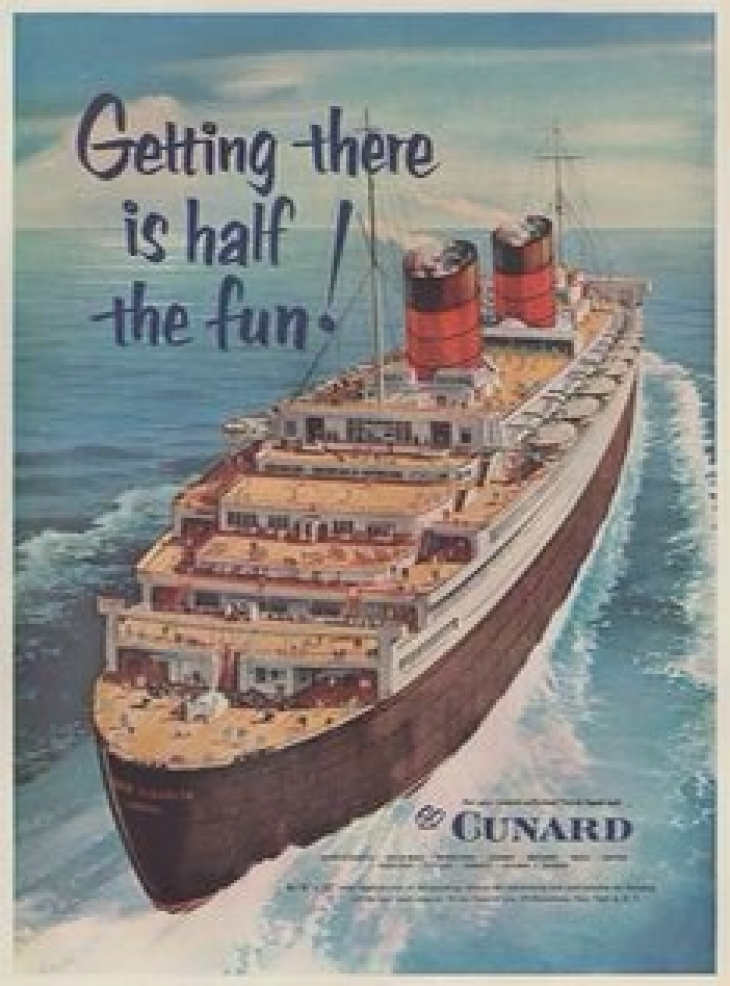
From the old mail liners that started transporting transatlantic passengers to the glamorous 1950s star-students cruise ships of the Golden Age, we explore the history of cruising to the gleaming mega ships of today.
Until the 1900s, the idea of travelling the seas in a ship for pleasure was an alien concept – it was merely a mode of transport from A-to-B. Transatlantic crossings weren’t possible by air, so the only option was the long journey on water. Initially this was purely practical, but as the route matured the style of cruising evolved to take on a life of its own. It became an experience in its own right, offering luxury and social networking opportunities that encouraged the moneyed elite to mingle, drink fine wines, dine on a gastronomic menu and travel to exciting destinations. Over time, the cost of cruising became more affordable, especially one aviation travel offered an alternative to sea routes. As an elite way to travel, cruising could still offer decadence and splendor but it also expanded to offer fantastic holiday option for families, regardless of wealth.
The Early Years
P&O Cruises were an early pioneer in the 19th century when it began offering cruises – indeed the company claims that co-founder Arthur Anderson invented the cruise holiday. He owned The Shetland Times, and to fill space he placed a dummy advert in his newspaper, promoting an imaginary cruise of the Scottish isles. This was in 1835 and it captured the imagination of those keen to see the world by boat. Companies began offering cruises to the public aboard ships that were primarily built for the transportation of mail with P& converting their liner Ceylon into what is regarded as the first cruise ship in 1881. It embarked on a round-the-world cruise from Liverpool and heralded the real beginning of cruising as we know it.

More luxurious
The early 20th century saw big names like Cunard and White Star entering the cruise market, with larger and more luxurious ships launched as the style of cruising continued to evole. Journeys that had been purely functional were now marketed as being for pleasure as cruise companies introduced new facilities – in 1907, the first swimming pool arrived alongside à la carte restaurants and lifts between decks. In these days, ships were still very much divided on a class system, where opulence in the interiors for those travelling in first class contrasted greatly with the facilities and conditions in the cheapest accommodation, or ‘steerage’. Unless you paid for a first class ticket, you were even expected to bring your own food and were crowned into small cabins.
There is plenty of evidence to suggest that it was the split class system of cruising that gave us the acronym that led to the word ‘posh’. This seems very credible, as on the long journeys, particularly those between the UK and India, wealthier passengers would demand cabins that were shadier in the afternoon so they would be cooler by bedtime, which would be the port side going out and the starboard side coming back, or Port Out Starboard Home, which was stamped on the ticket – from which the ‘POSH’ was derived.

Bespoke-built cruise ships
In 1900, the Hamburg America Line created the first purpose-built pleasure cruise ship - up until now the cruise ships had been liners that had previous transported goods and mail. It was a very exclusive affair, offering entirely first-class cabins and gave competitors P&O, Cunard, and White Star Line the impetus they needed to invest in the same. Itineraries developed too, with cruise companies offering a wider range of destinations on routes that made cruising a year-round affair. The Titanic disaster, in 1912, occurred just four days after the White Star Line ship left Southampton. Cunard’s Carpathia was deployed to rescue just over 700 survivors. It was just one incident of many that caused significant disruption to the cruise sector in this half-century.
World Wars 1 and 2 commandeered a number of cruise ships for military service with Fred. Olsen alone losing 23 ships in WWI, and 28 in WWII. Between these devastating wars, shipping lines were able to prosper to a degree, in particular what is now Costa Cruises thrived in producing and shipping olive oil to America. Also, in 1922, Cunard sent their ship Laconia on the very first world cruise. By 1948, Costa also broached passenger cruising, and ran a 16 day trip from Genoa to Rio de Janeiro and Buenos Aires. But it wasn’t until the 1950s when cruising finally claimed its rightful place – and the Golden Age of cruising was born.
Glamour travel
Once again, cruises became fun-filled social events synonymous with games, drinking, dancing, and even glamorous guests. In 1950 Cunard held an all-American star cruise, with special passengers Noel Coward, Judy Garland, Frank Sinatra, Elizabeth Taylor, Walt Disney, and Rita Hayworth on-board to entertain. Newer and more modern cruise lines were founded, offering a greater variety of style and vessels with Princess Cruises in 1965, Norwegian Cruise Line in 1966, Royal Caribbean in 1968, MSC in 1970, Carnival in 1972, Celebrity Cruises in 1989, and Silversea in 1994. The TV programme Love Boat, which was set on a Princess Cruises ship, ran from 1977 to 1990, and did much to raise the profile of cruising to new heights around the world.

Soon, cruising became no longer just a pursuit for the wealthy but for the discerning traveler too. Liners began offering types of rooms from stunning loft suites to well-appointed inside cabins. Modern day cruising continues to welcome huge as the main lines compete with one another to bring us bigger, better and more beautiful ships. New ideas are introduced frequently to add to the ‘wow factor’ with greater new technology added onboard each year, including the Royal Caribbean’s brilliant surf simulator, FlowRider, in 2004, the planetarium onboard Queen Mary 2 in 2009, and Norwegian Cruise Line’s race track in 2017. Also in 2017 Royal Caribbean built the largest cruise ship in the world, Symphony of the Seas, which can accommodate up to an incredible 6,680 passengers. Opulent spa suites, star-studded entertainment and 24/7 gourmet dining are now standard with the days of bringing your own food aboard definitely a thing of the past.




